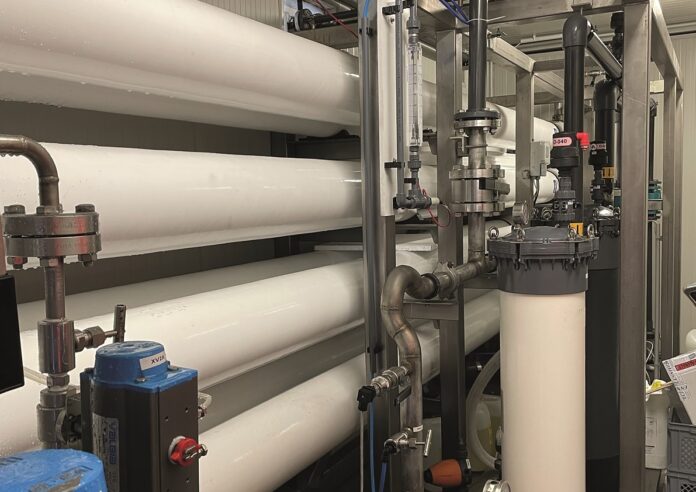Jac van Tuijn explains how a reverse osmosis technology is being piloted to desalinate water with varying salinity levels in a holiday hotspot.
Three Flemish water companies – Aquaduin, De Watergroep and Farys – are demonstrating a pilot plant near the Ganzepoot sea lock in Nieuwpoort, in western Belgium, to desalinate brackish water. The lock is situated in the IJzer river estuary where fresh river water mixes with seawater and, as a result, the salinity of this resource changes continuously. The utility companies are testing a closed circuit reverse osmosis (CCRO) plant that can adapt automatically to fluctuations in salt concentrations.
Flemish Minister for the Environment Zuhal Demir opened the Ganzepoot pilot project on 15 January 2022. The pilot is named after the lock complex where six waterways and the North Sea join, and fresh, brackish and salt water are available all year round.
The Belgian coast is a popular destination during the summer, resulting in increased demand for water in an area where freshwater resources are limited. The brackish water near the lock can provide much needed additional water resources.
CCRO technology allows the utility companies to treat feed water with varying salinity levels. In the summer, the feed water is more saline from the seawater that is utilised; contrastingly, in the winter, when more fresh water is available from inland rivers and waterways, the concentrations of salt in the feed water are reduced.
It is anticipated that salt concentrations in the feed water will range from a few mS/cm to more than 50 mS/cm at its peak. If the pilot is successful, a full-scale plant will be built by 2025 to provide drinking water for 30,000 families.
Speaking at the opening ceremony, the Minister said: “A water sensitive region such as West Flanders quickly bears the consequences of prolonged drought. As part of our ‘Blue Deal’, we are looking for new technologies to secure our water supply. This pilot paves the way, allowing us to tap into the North Sea – an infinite source for potable water during periods without rainfall.”
The intake for the CCRO installation is situated in the lock complex of Nieuwpoort, which is subject to tidal influences, as well as influences from the operation of the lock. The CCRO technology used for this pilot project has been developed by Israeli company Desalitech, acquired by DuPont in 2019.
Automatic control
The CCRO reacts automatically to the changing feed water and keeps the feed water in circulation until the desalination requirements are met. Another feature of the CCRO is the automated flushing mode, which is used to clean the membranes. By controlling the cleaning process, including the number of cycles and the variation of pressure and concentration prior to each flush, the fouling of the membranes is kept to a minimum, resulting in lower energy use and up to 98% water recovery. If new parameters need to be set, the system can be overridden manually.
In the case of Ganzepoot, the feed water is monitored closely by a network of nine conductivity sensors in the waters in and around the lock complex. This enables constant measurement of the salinity variations and optimisation of the desalination process, assuring the lowest possible energy and chemical use at the highest possible water recovery rate.
Dry holiday season
This CCRO plant has the potential to supply potable water all year round, reducing the necessity of the emergency responses that are currently required to support the local water company, Aquaduin, during dry holiday periods.
Johan Verbauwhede, Director-General of Aquaduin, speaking at the official opening of the pilot plant, highlighted how the three water companies were working together. Recognising the growing pressure that climate change is placing on water companies across the globe, he said: “Climate change is a challenge that transcends individual water companies. On behalf of Aquaduin, I can say that we are proud to be able to contribute to a more robust water supply, within and outside our region.”
If the project results in the delivery of a full-scale drinking water plant in Nieuwpoort, it is hoped that drinking water from the Ganzepoot plant can be distributed to the De Watergroep and Farys networks that serve other coastal cities. •








